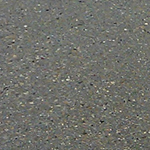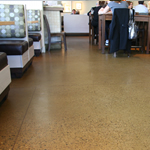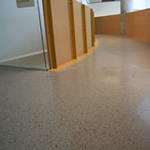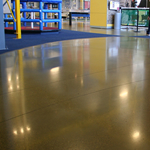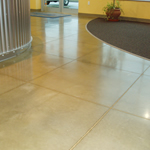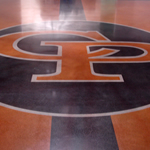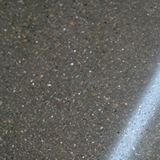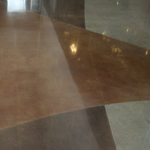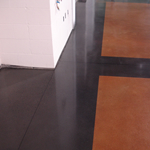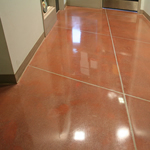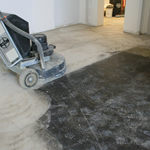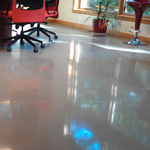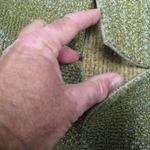Aggregate Exposure
The initial diamond grit level used to cut the floor will play a significant role in the overall look of the floor following completion. The amount of grinding significantly affects the overall cost of the system. There are four general options when considering aggregate exposure (according to the Concrete Polishing Association of America):
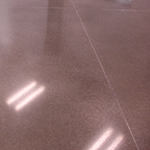
Fine Aggregate (Salt and Pepper): 1/16" removed, fine aggregate exposure with little or no medium aggregate exposure at random locations
Polish/Reflective Sheen Level
Penetrating Dye and Reactive Stain
In the past, acid stain was the only way to effectively add color to an existing concrete slab. The acid stain colors were very limited (effectively to earth tones). In the early 2000’s, concrete dyes were introduced specifically for the polished concrete industry. Essentially, concrete dyes are translucent, penetrating color solutions. Unlike acid-based stains, they do not react chemically with concrete. Instead, they contain very fine coloring agents that penetrate into the concrete surface. Both water and solvent-based dyes are available, with each type having unique qualities. Water-based dyes generally produce soft pastel tones. Bolder hues, including red, blue, yellow, green, purple, and orange, are possible with solvent-based products. Click here to view a color chart of our available options.
Integrally Colored Concrete
For new projects, the concrete can be colored at the batch plant. Unlike stains and dyes, integral color is continuous through the entire slab. While there are many integral color options, the overall color value is generally subdued. If a subtle color is the objective, integrally colored polished concrete is a viable option.
Seeded Aggregate
On new slabs, materials can be broadcast into the top of the slab prior to the trowelling process. The imagination is the only limitation, but some of the options are: recycled glass, marble and granite chips, metal nuts, bolts, and screws, gears, mother-of-pearl, mirror pieces, etc.
Decorative Saw-Cuts
Saw-cuts add another dimension to the finished floor and can break up the expansiveness of the concrete. Sweeping arcs delineating colors can create the look of terrazzo, where small squares/rectangles take on the look of large tile.
Edge Detail
The large grinding and polishing equipment only reaches to within an inch or two of the wall. Small edging machines are used to handle this detail work. Depending on the specific budget and aesthetic requirements of a given project, there are essentially three options for treating the edgework. The first option is to process the edges in the same manner as the field, providing a seamless transition and identical look. A second option is to stripe the edges with a slightly translucent edge tint or an opaque coating. This provides a different look and is a cost savings to the first option. The third option is to leave the edges untouched, and although unsightly, it provides a significant cost savings to the customer. Many customers, warehousing and manufacturing for instance, are generally not concerned with the look of the edges. Retail stores usually have 90% of the walls covered with shelving, so paying for edgework is unnecessary. In a corporate or university lobby, the requirements change. We can provide any of these options as determined by the customer. One major area where we separate ourselves dramatically from our competition is in the detail work of the edges.

Along with polished concrete, we also provide the following options and services.
Hardened and Dust-Proof Concrete
For facilities looking for a cost effective, relatively low maintenance, hard and dense surface, densified concrete is a viable option. Unlike polished concrete, densified concrete has no mechanical grinding, honing, or polishing. This process is simply the application of a reactive densifier. It is also more dependent on the concrete contractor to provide a well placed, well trowelled slab. The densifier will then protect and enhance the finish created by the placement contractor.
Joint Filling and Crack Repair
As they say in our industry, “Concrete is guaranteed to do two things: get hard and crack”. While this is true, properly cured slabs and well-designed control joint patterns significantly reduce the amount and severity of cracking. When cracking does occur, however, Surface Tech has state-of-the-art materials and equipment to fill them properly. As for the control joints (saw-cuts), we generally recommend a two-part catalyzed polyurea joint filler like Crete-Fill, by Curecrete. It is available in three shore hardness levels and is available in any color found in the Sherwin-Williams fan deck.
Floor Prep
We provide coating, mastic, and glue removal services for companies looking to cover the floor with coatings, tile, VCT, overlays, carpet, or any other floor finish. We also patch spalled areas in the concrete, as required.
Cementitious Overlays and Underlayments
When concrete is in poor condition due to erosion, buckling, excessive cracking, etc., we prepare the floor to receive a self leveling, cementitious topping which can then be treated as a brand new concrete floor. Grinding, polishing, staining, saw-cutting are all options at that point. As a preferred partner (Choice Contractor) of Ardex, we work only with the most advanced materials and systems to create the look and performance our customers desire.
Moisture Remediation
Perhaps the worst culprit of failed flooring systems is moisture migration from within the slab. This moisture causes tile, VCT, carpet, coatings, and other flooring materials to delaminate, pop, and bubble off of the concrete surface. We work with the most cutting-edge systems to remediate moisture migration, saving our customers costly downtime and headaches associated with floor repair.

